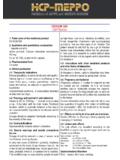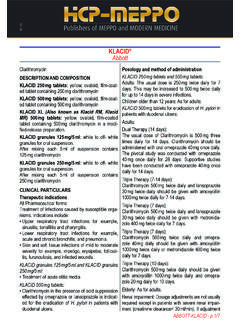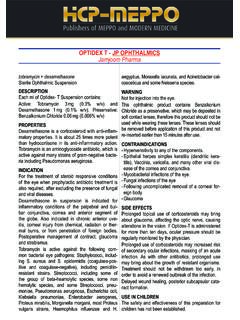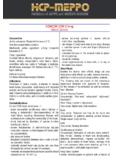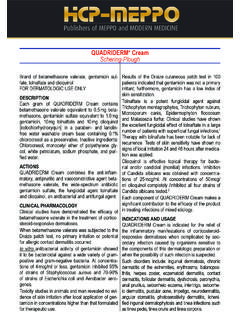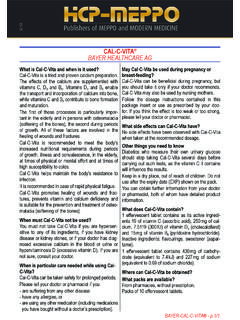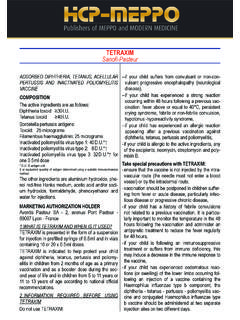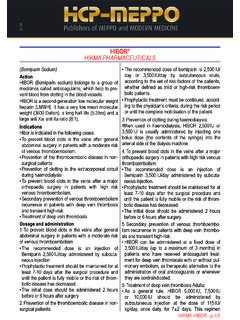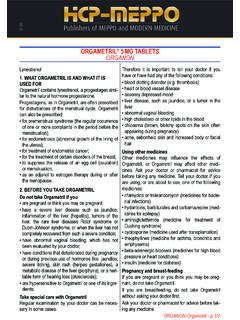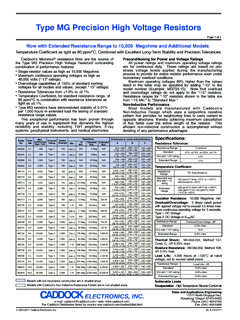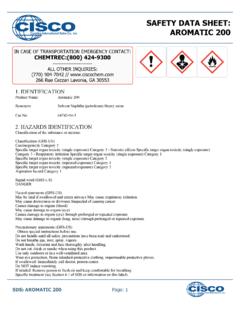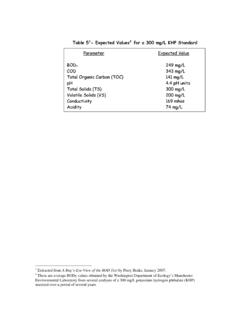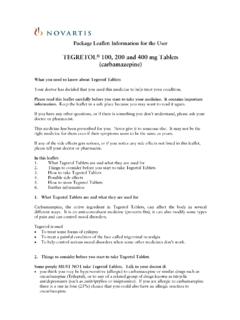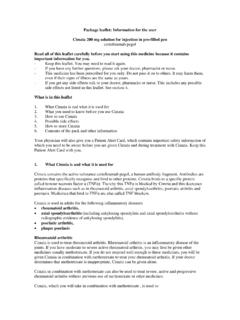Transcription of BETALOC ZOK 25 mg, 50 mg, 100 mg and 200 mg …
1 ASTRAZENECA- BETALOC ZOK 25 mg, 50 mg , 100 mg and 200 mg - recommended dosage in patients with mild to moderate hypertension is 50 mg BETALOC ZOK given once daily. In patients not responding to 50 mg the dose could be increased to 100 200 mg once daily and/or combined with other antihypertensive pectorisThe recommended dosage is 100 200 mg BETALOC ZOK given once daily. If needed, BETALOC ZOK can be combined with other antianginal symptomatic chronic heart failure with impaired systolic left ventricular function as an adjunct to existing heart failure therapyThe patients should have a stable chronic heart fail ure, without acute failure for the latest 6 weeks and an essentially unchanged basal therapy for the lat est 2 of heart failure with beta blockers may sometimes cause a temporary exacerbation of the symptoms picture.
2 In some cases, it is possible to continue the therapy or reduce the dose, and in other cases it may be necessary to discontinue the treatment. Initiation of BETALOC ZOK therapy in patients with severe heart failure (NYHA IV) should only be made by physicians especially trained in treatment of heart failure (see Special Warnings and Precautions for Use).Dosage in patients with stable heart failure, function class II:A recommended initial dosage for the first two weeks is 25 mg once two weeks, the dose can be increased to 50 mg once daily, and thereafter it can be doubled every second week.
3 The target dose for long term treatment is 200 mg once in patients with stable heart failure, function classes III IV:Recommended initial dose is mg (half a 25 mg tablet) given once daily. The dose should be indi vidually adjusted, and the patient should be closely metoprolol succinateCompositionEach tablet of BETALOC ZOK contains metoprolol suc cinate , , 95 and 190 mg corresponding to 25, 50, 100 and 200 mg of metoprolol formTablets with controlled release of ZOK 25 mg tablet is white to off white, oval, scored on both sides and marked A/ on one ZOK 50 mg tablet is white to off white, cir cular, scored on one side and marked AmO on the other ZOK 100 mg tablet is white to off white, cir cular.
4 Scored on the one side and marked AmS on the other ZOK 200 mg tablet is white to off white, oval, scored and marked AmY on one : to reduce blood pressure and to reduce the risk of cardiovascular and coronary mor tality (including sudden death), and symptomatic chronic heart failure with impaired systolic left ventricular function as an adjunct to existing heart failure of cardiac death and reinfarction after the acute phase of myocardial arrhythmias especially including supraven tricular tachycardia, reduction of ventricular rate in atrial fibrillation and in ventricular heart disorders with and method of administrationBetaloc ZOK is intended for once daily treatment and is preferably taken in the morning.
5 The BETALOC ZOK tablet should be swallowed with liquid. The tab lets and the divided halves should not be chewed or crushed. Concomitant intake of food does not influ ence the should be adjusted to avoid ZOK 25 mg, 50 mg , 100 mg and 200 mg ASTRAZENECA10 14 ASTRAZENECA- BETALOC ZOK 25 mg, 50 mg , 100 mg and 200 mg - block of second or third degree, patients with unstable decompensated cardiac heart failure (pulmonary oedema, hypoperfusion or hypo tension), and patients with continuous or intermit tent inotropic therapy acting through beta receptor agonism.
6 Marked clinically relevant sinus bradycar dia, sick sinus syndrome, cardiogenic shock, severe peripheral arterial circulatory should not be given to patients with sus pected acute myocardial infarction as long as the heart rate is < 45 beats/min, the P Q interval is > sec or the systolic blood pressure is < 100 mm Hg. BETALOC ZOK is contra indicated in patients who have shown hypersensitivity to any component of the product or to other warnings and precautions for useIntravenous administration of calcium antagonists of the verapamil type should not be given to patients treated with blockers.
7 Generally when treating patients with asthma, con comitant therapy with a 2 agonist (tablet and/or aerosol) should be administered. The dosage of 2 agonists may require adjustment (increase) when treatment with BETALOC ZOK is started. The risk of BETALOC ZOK interfering with 2 receptors is however less than with conventional tablet formula tions of 1 selective treatment with BETALOC ZOK, the risk of interfering with carbohydrate metabolism or mask ing hypoglycaemia is likely to be less than during treatment with conventional tablet formulations of 1 selective blockers and much less than with non selective suffering from heart failure should have their decompensation treated both before and during treatment with BETALOC rarely, a pre existing A V conduction disorder of moderate degree may become aggravated (pos sibly leading to A V block).
8 If the patients develop increasing bradycardia, BETALOC ZOK should be given in lower doses or gra dually ZOK may aggravate the symptoms of peripheral arterial circulatory disorders, mainly due to its blood pressure lowering during the increase of the dosage as heart failure symptoms may be aggravated in some patients. After 1 2 weeks, the dose can be raised to 25 mg given once daily. Then, after further two weeks, the dosage can be increased to 50 mg given once daily. In those patients who tolerate a higher dose, the dosage can be doubled every second week up to a maximal dose of 200 mg daily.
9 In case of hypotension and/or bradycardia, decrease in concomitant medication or lowering of the BETALOC ZOK dose may be necessary. Initial hypotension does not necessarily mean that the dose of BETALOC ZOK cannot be tolerated in chronic treatment, but the dose must not be raised until the condition has been stabilised, and increased control of renal func tion, among other things, may be arrhythmiasThe recommended dosage is 100 200 mg BETALOC ZOK given once treatment after myocardial infarctionLong term oral treatment with metoprolol in doses of 200 mg given once daily has been shown to reduce the risk of death (including sudden death)
10 , and to reduce the risk of reinfarction (also in patients with diabetes mellitus).Functional heart disorders with palpitationsThe recommended dosage is 100 mg once daily. If needed, the dose can be increased to 200 prophylaxisThe recommended dosage is 100 200 mg once renal functionDose adjustment is not needed in patients with impaired renal hepatic functionDose adjustment is normally not needed in patients suffering from liver cirrhosis because metoprolol has a low protein binding (5 10%). When there are signs of serious impairment of liver function ( shunt oper ated patients) a dose reduction should be adjustment is not needed in the is limited experience with BETALOC ZOK treat ment in ZOK 25 mg, 50 mg , 100 mg and 200 mg - given together with calcium antagonists of the verapamil and diltiazem type and/or antiarrhythmic agents.
